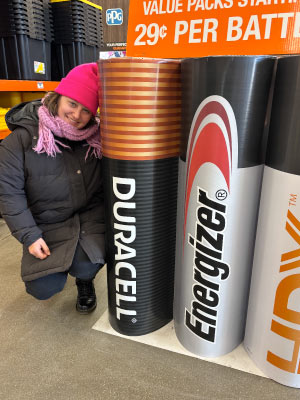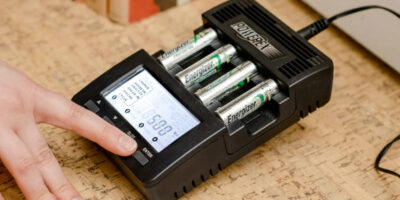
What’s the best surge protector on the market? Which portable charger is going to last me the longest? How do I recycle batteries? If you’ve had any of these questions, you might want to see what Sarah Witman has to say. Witman is a writer for Wirecutter, the New York Times’ product recommendation service. She specializes in reviewing batteries and chargers for all kinds of devices, from electric vehicles to smartphones.
Witman’s career in journalism started in high school, where she wrote for — and later became an editor of — her school’s newspaper. “It made me realize that I liked being able to dive into topics that I’m curious about or interested in,” she says. After high school, Witman continued her studies at the University of Wisconsin–Madison, graduating from the university’s journalism school.

In addition to her love of journalism, Witman also had another passion — the environment. She recalls a “wave of environmentalism” happening while she grew up, which pushed her to pursue a certificate in environmental studies when she started at UW–Madison. “Climate change has always been something that I cared about, and I wanted to be able to use my journalism skills to help the environment,” says Witman.
To Witman, UW–Madison’s rich history of journalism and environmental studies made it the perfect place to study both. “I was really involved in the Badger Herald all four years of college,” she says. “I was an editor for the arts section, but I did try to write a few environmental-related pieces while I was there.” Sometime after Witman’s graduation from UW–Madison, the paper added an entire section of their paper dedicated to science news, something that Witman is excited to see.
In 2017, Witman started writing for Wirecutter, a branch of the New York Times that covers product reviews and recommendations. Before she started specializing in batteries and chargers, Witman reviewed a variety of household items. Her favorite item to review? Mousetraps. “A mousetrap is such a seemingly mundane thing, but something that most people end up needing,” she says. “I talked to a lot of interesting people that know a lot about mousetraps, and I learned that preventing mice from getting into your house is much more effective than mouse traps are. Instead of thinking of a mouse infestation as an intrusion on your space, it’s helpful to realize that we actually are invading their habitat.”

Now a senior staff writer for Wirecutter, Witman focuses on chargers and batteries — “anything that has to do with powering another thing,” she says. “I research, test, and review all different kinds of technology.” When reviewing these chargers, Witman often has to speak with experts to learn more about the inner workings of the technology she’s testing. To her, the science writing foundation she gained from her environmental studies education has helped her learn and write about the technology behind the products she’s reviewing. “Being able to talk to engineers and scientists, and being able to understand technical things and synthesize them for a wider audience are valuable skills,” she says.

Since finding her niche with batteries and chargers, Witman gets to test some of the latest technology for Wirecutter — like at-home electric vehicle chargers. “Writing the guide was so interesting. They had me rent two electric vehicles, and test them with all these different chargers,” Witman says. “People have a lot of questions about these types of things. I’m writing for someone who might want to someday own an electric vehicle, so when they’re ready to make that transition, they’ll know that there’s information out there, making it less of a scary experience for them.”
Witman has also written about many other sustainable technologies, such as solar chargers, battery recycling, and portable power stations, which are large-scale portable batteries. “When I first started writing about these things at Wirecutter, it was more of a niche area. It’s so cool to see so many more companies making these types of things now — especially with there being more natural disasters than ever — giving people the option to use battery and solar-powered energy instead of gas generators.”
When writing her tech reviews, Witman uses a sustainable approach to make environmentalism accessible for all audiences. “People want to know what they can do to help the environment on a consumer level, so I try to meet people where they’re at and remove barriers for living more sustainably,” she says. By combining her journalism expertise and commitment to bettering the environment, Witman shows that by making informed decisions — like picking a charger that’s built to last or properly recycling electronics — everyone has the power to help combat climate change.